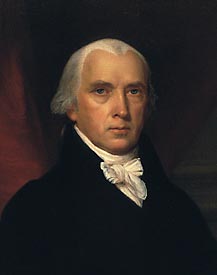 We go through eras of founders in this country. We all have our favorites, and our leaders do, too.
We go through eras of founders in this country. We all have our favorites, and our leaders do, too.
Some admire the leadership of Washington. He was huge in the 19th century. Others go for the intellectual curiosity of Jefferson, and he was big when I was a kid. My dad was fond of Franklin, and there is a Franklin for every taste. My father-in-law loved the entrepreneurial Franklin, my dad preferred the old roue, and I like the inventor Franklin. We have just gone through a big John Adams vogue, which began with the love story 1776 (co-starring Abigail), continued with the David McCullough biography, and concluded with Paul Giamatti's star turn in the HBO version of it.
The next great founder will be James Madison. (Painting from life by John Vanderlyn in 1816.) Madison avoided the Revolution. He was a recent graduate of Princeton, he was sickly. (Although he lived to be 87, so it may have been hypochondria.) He was short and thin, he was quiet and shy, he was never an orator and not diplomatic.
 He was, at heart a student. If you like your heroes studious, organized and bright, good writers who have facts marshaled and not just rhetoric, you will like James Madison.
He was, at heart a student. If you like your heroes studious, organized and bright, good writers who have facts marshaled and not just rhetoric, you will like James Madison.
The beginning of Madison's vogue can be precisely dated to September 17, 2008. This was anniversary of the date the document was finished, and Madison is credited as its primary mover, its “father.”
We can date the Madison vogue precisely because that was the day his old home, Montpelier, opened as a museum. It had been owned by the DuPont family for almost a century, used as a horse farm breeding, among others, a Grand National champion named Battleship. But with Alice DuPont's death in 1983, its 5000 acres passed under her will to the nation. In 2000 it came under the control of the National Trust for Historic Preservation, which spent the next 8 years taking the DePont mansion down to its Madison-era core.
My daughter and I visited over the weekend.
That core looks much more like a house you or I might live in than Jefferson's Monticello. It has three front pillars, rooms arranged around a squarish hallway, and it's built with the same wood-and-plaster lathe technique of my own 1921 homestead. Since Dolley sold the place back in 1844, there is not much to see, but the curators have done their best. They found a desk, a table, and a period china cabinet. They've arranged a dinner party of cardboard cutouts in the main salon, James and Dolley seated alongside Monroe, Jefferson, and Lafayette, among others.
 And then, guide Jim Walker told us, we come to the most important room in America. Follow me, upstairs.
And then, guide Jim Walker told us, we come to the most important room in America. Follow me, upstairs.
It's a smallish room at the front of the second floor, with a window aimed at the Blue Ridge mountains to the west. Here, at a wooden desk, and surrounded by books in several languages, Madison spent much of 1786 studying confederations, how they fell, and what successful governments had in common. The result became known as the Virginia Plan, and when the second Constitutional Convention opened in Philadelphia – it followed a failed attempt at Annapolis, and was technically meant only to amend the Articles of Confederation – Madison offered it as the basis for discussion.
The final result was heavily amended. It was not all he wanted, it was not all any of the 55 delegates wanted. The process was like all legislative sausage-making, just as ugly as what you can see on C-Span.
Its main legislative purpose was to accommodate slavery. Madison was a slave holder, and the staff at Montpelier makes this fact an essential element in their presentation. Madison called his slaves “servants,” he sought to never break up families, he treated his people as well as anyone in the area, but it was still slavery.
 The trust is rebuilding the shacks near the mansion where the house slaves lived, and in time may plant a garden along the lines of that which fed the family. Across the road is a shack erected after the War by a Madison family slave named George Gilmore. And also along the road is a restored train station, restored specifically to 1910, with separate doors marked “white” and “colored,” just as it was.
The trust is rebuilding the shacks near the mansion where the house slaves lived, and in time may plant a garden along the lines of that which fed the family. Across the road is a shack erected after the War by a Madison family slave named George Gilmore. And also along the road is a restored train station, restored specifically to 1910, with separate doors marked “white” and “colored,” just as it was.
What's most exciting about Montpelier to me is what it might become. What might it look like when its original furnishings are in place, with the right wallpaper on the walls, when the shacks are finished and black docents join the white to explain how life really was back in the day. Walker told us there was a family of mice that had a nest deep inside the house, that they collected bits of string and paper over the years, that many date from Madison's time, including a part of a letter in his own hand, and that these may act as guides in the restoration. (I smell a best-selling kids' book!)
The story Montpelier will tell will be far more nuanced than that told by any other founder, because it will be told through the eyes of our time. Madison nearly lost this country in the War of 1812, his document's compromises were shredded by the Civil War, yet those compromises remain our basis of government, used by no other country. In some ways Montpelier is a haunted house, and its message ambiguous.
Anyway it spoke to me. And it spoke to our time, a time when divisions and distrust have many of us wondering if Madison's experiment in balance can long endure, or whether it was just a scheme for an empire whose day is now done.
Madison would understand. He lived with that ambiguity, and with compromises, all his life. It took all his intellect and all his study to create from ambiguity and compromise a structure that would work until his 1836 death, and I'm sure he'd be amazed that the structure still stands, held together through time by wealth, and blood sacrifice, by belief and faith in the future.
I still have that faith. You should too.









